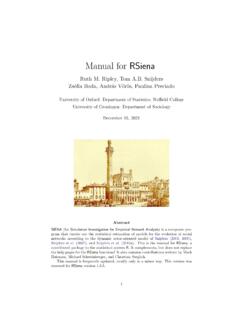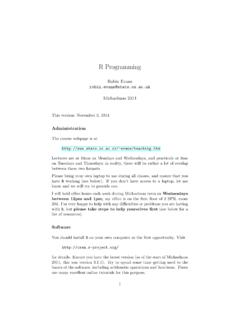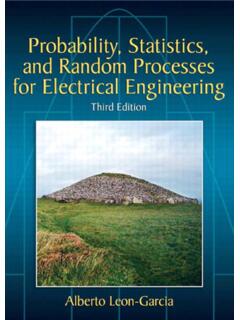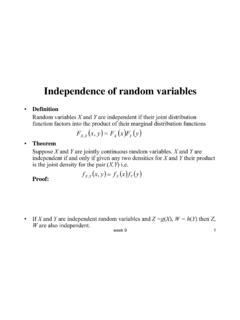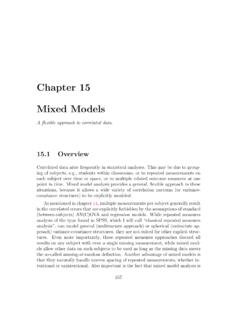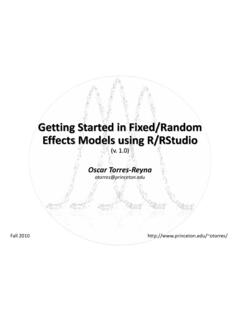Transcription of Fixed and random effects - University of Oxford
1 Snijders, Tom Fixed and random effects . In: Everitt and Howell (eds.), Encyclopedia of Statistics in Behavioral Science. Volume 2, 664-665. Chicester (etc.): Wiley, 2005. Fixed and random effects Author: Tom Snijders Abstract: In performing a multilevel analysis, what is a level? And when should a variable have a random slope? This depends on whether the units in the design should be regarded as being representative of a population, and on whether the researcher wishes to draw conclusions primarily about the observed units, or primarily about the population.
2 Keywords: Fixed effects , random effects , linear model, multilevel analysis, mixed model, population, dummy variables. Fixed and random effects In the specification of multilevel models, as discussed in [1] and [3], an important question is, which explanatory variables (also called independent variables or covariates) to give random effects . A quantity being random means that it fluctuates over units in some population; and which particular unit is being observed, depends on chance. When some effect in a statistical model is modeled as being random , we mean that we wish to draw conclusions about the population from which the observed units were drawn, rather than about these particular units themselves.
3 The first decision concerning random effects in specifying a multilevel model is the choice of the levels of analysis. These levels can be, , individuals, classrooms, schools, organisations, neigborhoods, etc. Formulated generally, a level is a set of units, or equivalently a system of categories, or a classification factor in a statistical design. In statistical terminology, a level in a multilevel analysis is a design factor with random effects . What does this mean? The main point of view that qualifies a set of units, , organisations, as a level in the multilevel sense is that the researcher is not primarily interested in the particular organisations (units) in the sample, but in the population (the wider set of organisations) for which the observed units are deemed to be representative.
4 Statistical theory uses the word exchangeability , meaning that from the researcher s point of view any unit in the population could have taken the place of each unit in the observed sample. (Whether the sample was drawn randomly according to some probability mechanism is a different issue sometimes it can be argued that convenience samples or full population inventories can reasonably be studied as if they constituted a random sample from some hypothetical larger population.) It should be noted that what is assumed to be exchangeable are the residuals (sometimes called error terms) associated with these units, which means that any Fixed effects of explanatory variables are already partialed out.
5 In addition, to qualify as a non-trivial level in a multilevel analysis, the dependent variable has to show some amount of residual, or unexplained, variation, associated with these units: , if the study is about the work satisfaction (dependent variable ) of employees (level-one units) in organisations (level-two units), this means that employees in some organisations tend to have a higher satisfaction than in some other organisations, and the researcher cannot totally pin this down to the effect of particular measured variables. The researcher being interested in the population means here that the researcher wants to know the amount of residual variability, , the residual variance, in average work satisfaction within the population of organisations (and perhaps also in the more complicated types of residual variability discussed below).
6 If the residual variance is zero, then it is superfluous to use this set of units as a level in the multilevel analysis. A next decision in specifying a multilevel model is whether the explanatory variables considered in a particular analysis have Fixed or random effects . In the example, such a variable could be the employee s job level: a level-one variable , since it varies over employees, the level-one units. The vantage point of multilevel analysis is that the effect of job level on work satisfaction ( , the regression coefficient of job level), could well be different across organisations.
7 The Fixed effect of this variable is the average effect in the entire population of organisations, expressed by the regression coefficient. Since mostly it is not assumed that the average effect of an interesting explanatory variable is exactly zero, almost always the model will include the Fixed effect of all explanatory variables under consideration. When the researcher wishes to investigate differences between organisations in the effect of job level on work satisfaction, it will be necessary to specify also a random effect of this variable , meaning that it is assumed that the effect varies randomly within the population of organisations, and the researcher is interested to test and estimate the variance of these random effects across this population.
8 Such an effect is also called a random slope. When there are no theoretical or other prior guidelines about which variables should have a random effect, the researcher can be led by the substantive focus of the investigation, the empirical findings, and parsimony of modeling. This implies that those explanatory variables that are especially important or have especially strong effects could be modeled with random effects , if the variances of these effects are important enough as evidenced by their significance and size, but one should take care that the number of variables with random effects should not be so large that the model becomes unwieldy.
9 Modeling an effect as random usually although not necessarily goes with the assumption of a normal distribution for the random effects . Sometimes this is not in accordance with reality, which then can lead to biased results. The alternative, entertaining models with non-normally distributed residuals, can be complicated, but methods were developed, see [2]. In addition, the assumption is made that the random effects are uncorrelated with the explanatory variables. If there are doubts about normality or independence for a so-called nuisance effect, , an effect the researcher is interested in not for its own sake but only because it must be statistically controlled for, then there is an easy way out (at least for linear models).
10 If the doubts concern the main effect of a categorical variable , which also would be a candidate for being modeled as a level as discussed above, then the easy solution is to model this categorical control variable by Fixed effects , , using dummy variables for the units in the sample. If it is a random slope for which such a statistical control is required without making the assumption of residuals being normally distributed and independent of the other explanatory variables, then the analogue is to use an interaction variable obtained by multiplying the explanatory variable in question by the dummy variables for the units.



